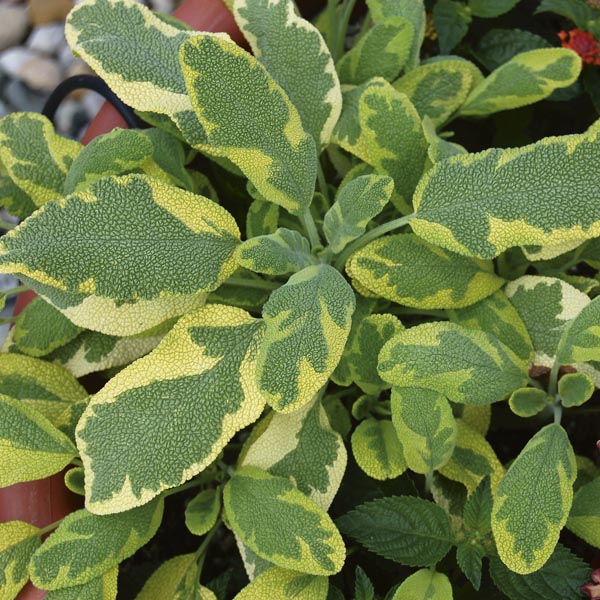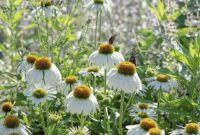Sage Golden, with its striking golden foliage and aromatic leaves, is a delightful addition to any herb garden.
Not only does it provide visual appeal, but it also offers a unique flavor profile and several potential health benefits.
Whether you’re a seasoned gardener or a novice looking to cultivate this beautiful herb, here are some tips to ensure your Sage Golden thrives in your garden.
1. Choose the Right Location:
Selecting the appropriate location is crucial for the successful growth of Sage Golden. Here’s a detailed breakdown of what to consider:
a. Sunlight Requirements:
Sage Golden thrives in full sunlight. This means it needs at least 6 to 8 hours of direct sunlight each day.
When choosing a spot in your garden, observe it throughout the day to ensure it receives adequate sunlight.
If your chosen location is shaded for a significant portion of the day, your Sage Golden may not grow as robustly, and its vibrant golden foliage may lose some of its luster.
b. Soil Quality:
The soil in your chosen location should be well-draining. Sage Golden prefers soil that allows excess water to flow away from the roots to prevent waterlogged conditions, which can lead to root rot.
You can improve drainage by amending the soil with organic matter like compost.
Additionally, Sage Golden prefers slightly alkaline soil with a pH level between 6.0 and 7.0. You can test your soil’s pH using a soil testing kit available at gardening supply stores.
c. Air Circulation:
Adequate air circulation around your Sage Golden plants is essential to prevent the development of fungal diseases.
Planting them too closely together can restrict airflow, so make sure to space them about 18 to 24 inches apart.
This spacing allows each plant to receive enough air and light to grow healthily.
d. Protection from Strong Winds:
While Sage Golden prefers well-ventilated areas, it’s also important to consider potential strong winds in your chosen location.
Extremely strong winds can damage or break the delicate branches of Sage Golden. If your garden is prone to strong winds, consider planting your Sage Golden near a windbreak or using stakes and ties to support the plant during windy conditions.
In summary, selecting the right location for your Sage Golden involves ensuring it receives
2. Soil Preparation:
Preparing the soil correctly is a fundamental step to ensure Sage Golden thrives in your herb garden. Here’s a more detailed explanation of what’s involved:
a. Soil Type:
Sage Golden prefers slightly alkaline soil with a pH level ranging between 6.0 and 7.0. Before planting, it’s essential to test your soil’s pH using a soil testing kit available at garden centers.
If your soil is too acidic (below pH 6.0), you can raise the pH by adding lime to make it more alkaline.
Conversely, if the soil is too alkaline, you can lower the pH by adding organic matter like peat moss.
b. Soil Structure:
Good soil structure is vital for Sage Golden’s root health. It should be well-draining to prevent water from pooling around the roots and causing rot.
If your soil doesn’t naturally drain well, you can improve its drainage by incorporating organic matter like compost. This not only enhances drainage but also enriches the soil with essential nutrients.
c. Organic Matter:
Adding organic matter, such as compost or well-rotted manure, is beneficial for enriching the soil and providing essential nutrients to your Sage Golden plants.
Organic matter also enhances soil structure and encourages beneficial microorganisms that support plant growth.
d. Soil Preparation Steps:
- Begin by clearing the area of any weeds, rocks, or debris that could impede Sage Golden’s growth.
- Use a spade or garden fork to turn the soil to a depth of about 12 inches (30 cm). This loosens compacted soil and helps with root penetration.
- Incorporate the recommended amount of organic matter into the soil. This typically involves spreading a 2- to 3-inch (5-7.5 cm) layer of compost or well-rotted manure over the planting area and then mixing it thoroughly into the top 6 to 8 inches (15-20 cm) of soil.
- Smooth the soil’s surface and create a slight mound to improve drainage, especially if your garden has a tendency to become waterlogged.
e. Soil Maintenance:
Regularly monitoring the soil’s moisture content and quality is important throughout the growing season.
Aim to keep the soil consistently moist but not waterlogged. Mulching around your Sage Golden plants with organic materials like straw or shredded leaves can help retain moisture, regulate soil temperature, and reduce weed competition.
In conclusion, proper soil preparation for Sage Golden involves addressing soil pH, improving soil structure, adding organic matter, and maintaining moisture levels.
By paying attention to these details, you create an optimal growing environment that supports the health and vitality of your Sage Golden herb plants.
3. Planting Sage Golden:
Planting Sage Golden properly is essential to establish healthy and thriving herb plants. Here’s a detailed explanation of the steps involved:
a. Timing:
- Sage Golden is typically planted in the spring after the last frost date in your area. Check your local climate and frost dates to determine the best time to plant. Planting too early can expose your young Sage Golden to frost damage.
b. Selecting Seedlings or Seeds:
- You can start Sage Golden from seeds or purchase seedlings from a nursery or garden center. Seedlings are a convenient option as they have a head start on growth. If you choose to start from seeds, sow them indoors 6-8 weeks before your planned outdoor planting date.
c. Spacing:
- When planting Sage Golden, ensure adequate spacing between plants. Sage Golden plants should be spaced approximately 18 to 24 inches (45 to 60 cm) apart. This spacing allows each plant to receive sufficient sunlight and air circulation for healthy growth.
d. Soil Preparation:
- As mentioned earlier, prepare the soil in your chosen location by ensuring it has the right pH level and good drainage. Incorporate organic matter like compost to enrich the soil and improve its texture.
e. Planting Depth:
- Plant your Sage Golden seedlings or seeds at the same depth they were in their original containers. If you’re transplanting seedlings, dig a hole that accommodates the root ball without crowding or bending the roots. If you’re planting seeds, follow the seed packet’s instructions for the appropriate planting depth.
f. Watering:
- After planting, water the Sage Golden thoroughly to settle the soil around the roots and provide initial moisture. Continue to monitor soil moisture in the following weeks and water when the top inch (2.5 cm) of soil feels dry. Be cautious not to overwater, as Sage Golden prefers slightly drier conditions compared to some other herbs.
g. Mulching:
- Applying a layer of organic mulch around the base of your Sage Golden plants can help retain soil moisture, suppress weeds, and maintain more stable soil temperatures. Mulch also protects the plant’s roots from temperature fluctuations.
h. Maintenance:
- As your Sage Golden plants grow, you may need to provide support for them if they become top-heavy or if strong winds are common in your area. You can use stakes and ties to secure the plants as needed.
4. Watering Sage Golden:
Proper watering is crucial for the health and growth of Sage Golden. Here’s a detailed breakdown of how to water this herb:
a. Watering Frequency:
- Sage Golden prefers moderate moisture levels. The key to successful watering is maintaining soil that is evenly moist but not waterlogged. As a general guideline, water your Sage Golden when the top inch (about 2.5 cm) of soil feels dry to the touch. Stick your finger into the soil near the plant base to gauge moisture levels.
b. Watering Technique:
- When watering, it’s important to provide water at the base of the plant, near the root zone. Avoid wetting the foliage, as this can increase the risk of fungal diseases. You can use a soaker hose, drip irrigation, or a watering can with a spout that allows for precise watering at the root level.
c. Morning Watering:
- The ideal time to water Sage Golden is in the morning. Morning watering allows the plant’s foliage to dry off during the day, reducing the chances of fungal issues that can occur when the leaves stay wet for prolonged periods.
d. Avoid Overwatering:
- Overwatering is a common mistake that can lead to root rot and other problems for Sage Golden. To prevent overwatering, ensure that the soil has good drainage. If the soil remains consistently waterlogged, the roots can suffocate and rot. Adjust your watering frequency based on your specific soil conditions and climate.
e. Rainfall Considerations:
- Be mindful of natural rainfall. If your area receives regular rain, adjust your watering schedule accordingly. During rainy periods, you may need to water less frequently, while in dry spells, you’ll need to increase your watering.
f. Mulch:
- Applying a layer of organic mulch around the base of your Sage Golden plants can help conserve soil moisture by reducing evaporation. Mulch also prevents weed growth, which can compete for water and nutrients with your Sage Golden.
g. Container Planting:
- If you’re growing Sage Golden in containers, ensure the pots have drainage holes to prevent water from pooling at the bottom. Container-grown Sage Golden may need more frequent watering than those in the ground because containers tend to dry out faster.
h. Drought Tolerance:
- Sage Golden is relatively drought-tolerant once established. As it matures, it develops a more extensive root system that can access deeper soil moisture. This means you can gradually reduce watering frequency as the plant becomes more self-sufficient.
5. Mulch for Sage Golden:
Mulching is a beneficial practice for your Sage Golden herb garden. It helps conserve moisture, control weeds, regulate soil temperature, and promote overall plant health. Here’s a detailed breakdown of how to use mulch effectively:
a. Mulch Type:
- When mulching around your Sage Golden plants, opt for organic mulch materials such as straw, shredded leaves, compost, or wood chips. These materials decompose over time, enriching the soil with organic matter and nutrients.
b. Mulch Thickness:
- Apply a layer of mulch that’s approximately 2 to 3 inches (5-7.5 cm) thick around the base of your Sage Golden plants. This thickness provides adequate coverage without smothering the plant or causing excessive moisture retention.
c. Mulch Placement:
- Spread the mulch evenly around the base of the Sage Golden plants, extending it out to the drip line (the area beneath the outermost branches). This ensures that the entire root zone benefits from the mulch’s effects.
d. Moisture Retention:
- One of the primary benefits of mulch is its ability to retain moisture in the soil. Mulch acts as a barrier, reducing water evaporation from the soil surface. This is especially beneficial during dry periods when your Sage Golden plants need consistent moisture.
e. Weed Control:
- Mulch also serves as a natural weed suppressant. It creates a barrier that prevents weed seeds from germinating and competing with your Sage Golden for water and nutrients. This reduces the need for frequent weeding and minimizes soil disturbance.
f. Temperature Regulation:
- Mulch helps stabilize soil temperatures by insulating the soil. In hot weather, it keeps the soil cooler, which is beneficial for Sage Golden, as it prefers moderate temperatures. In colder weather, mulch provides some protection against frost.
g. Avoid Mulch Contact with Plant Stems:
- When applying mulch, ensure that it doesn’t come into direct contact with the stems of your Sage Golden plants. Mulch piled against the stems can trap moisture and promote rot or disease. Leave a small gap (a few inches) between the mulch and the base of the plants.
h. Renewing Mulch:
- Over time, organic mulch materials break down and decompose. To maintain its benefits, you may need to replenish the mulch layer periodically, typically once a year in the spring. Rake away the old mulch if it has significantly decomposed, and apply a fresh layer.
i. Consideration for Container Gardening:
- If you’re growing Sage Golden in containers, you can also use mulch on the surface of the potting soil. This helps retain moisture and maintain more stable temperatures within the container.
j. Organic Matter Contribution:
- As the mulch breaks down, it adds organic matter to the soil, improving its structure and fertility. This gradual enrichment benefits your Sage Golden plants over the long term.
6. Pruning and Harvesting Sage Golden:
Proper pruning and harvesting are essential for maintaining the health and vitality of your Sage Golden plants, whether you’re using them for culinary purposes or simply for their aesthetic value. Here’s a detailed explanation of these important tasks:
a. Pruning Sage Golden:
- Bushiness and Shape: Pruning Sage Golden encourages bushy growth and helps maintain an attractive shape. It prevents the plant from becoming leggy or overgrown. You can start pruning once your Sage Golden plant is well-established, usually a few months after planting.
- Timing: The best time to prune Sage Golden is in the spring, just before new growth begins. However, you can also lightly prune throughout the growing season to shape the plant and remove dead or diseased branches.
- Tools: Use sharp, clean pruning shears or scissors for pruning. This minimizes damage to the plant and reduces the risk of disease transmission.
- Technique: To prune Sage Golden, identify the branches that need trimming. Cut them just above a set of leaves or nodes, ensuring that the cut is clean and not ragged. This encourages new growth from the nodes.
- Deadheading: Regularly remove spent or fading flowers (a practice known as deadheading). This not only keeps the plant looking tidy but also redirects its energy into producing more foliage.
b. Harvesting Sage Golden:
- Timing: You can start harvesting Sage Golden leaves once the plant has reached a sufficient size, which is typically after the first few months of growth. Harvest in the morning when the aromatic oils are most concentrated. Avoid harvesting during the hottest part of the day.
- Method: Use sharp scissors or pruning shears to snip off the leaves or branches you want to harvest. Make clean cuts just above a leaf node. This encourages new growth from the node and prevents the plant from becoming too leggy.
- Harvesting Frequency: You can harvest Sage Golden leaves as needed throughout the growing season. However, avoid removing more than one-third of the plant at a time to ensure it continues to thrive.
- Drying and Storage: If you want to preserve Sage Golden for later use, you can dry the harvested leaves. Simply bundle the leaves and hang them in a dry, well-ventilated area out of direct sunlight. Once dry, store them in an airtight container away from light and moisture.
- Pruning During Harvest: While harvesting Sage Golden, you can simultaneously prune the plant by removing any woody or overgrown branches. This helps maintain the plant’s shape and encourages new, tender growth.
- End-of-Season Pruning: As the growing season comes to a close, consider doing a more thorough pruning to remove any dead or damaged branches and prepare the plant for winter.
7. Fertilization for Sage Golden:
Fertilizing Sage Golden is essential to ensure it receives the necessary nutrients for healthy growth and robust foliage.
Here’s a detailed explanation of how to fertilize this herb effectively:
a. Soil Testing:
**1. Before you start fertilizing your Sage Golden plants, it’s a good practice to conduct a soil test. This test can determine the current nutrient levels in your soil and help you make informed decisions about which fertilizers to use and in what quantities.
b. Type of Fertilizer:
- Sage Golden typically thrives with a balanced, all-purpose fertilizer. Look for a granular or slow-release fertilizer with a balanced N-P-K ratio, which stands for nitrogen (N), phosphorus (P), and potassium (K). A balanced fertilizer, such as 10-10-10 or 14-14-14, is suitable.
- Organic Options: If you prefer organic gardening, you can opt for organic fertilizers such as compost, well-rotted manure, or commercial organic blends. These materials not only provide nutrients but also improve soil structure over time.
c. When to Fertilize:
- The best time to fertilize Sage Golden is in the early spring, just as new growth begins. This provides the plant with the nutrients it needs for the growing season.
- You can also apply a second round of fertilizer in mid-summer if your Sage Golden shows signs of slow growth or nutrient deficiency. Be cautious not to over-fertilize, as excessive nutrients can lead to excessive foliage growth at the expense of flavor.
d. Application Rate:
**1. Follow the recommended application rate on the fertilizer packaging or the guidelines provided by your soil test results. Typically, you’ll sprinkle the fertilizer evenly around the base of the plant, avoiding direct contact with the stems.
e. Watering After Fertilization:
**1. After applying fertilizer, water your Sage Golden thoroughly. This helps dissolve the fertilizer and carry the nutrients down to the root zone. It also reduces the risk of fertilizer burn.
f. Avoid Over-Fertilization:
**1. Over-fertilization can harm your Sage Golden. Always follow the recommended application rates, and never exceed them. Excessive fertilizer can lead to nutrient imbalances, salt buildup in the soil, and decreased plant health.
g. Adjusting Fertilizer Application:
**1. Pay attention to your Sage Golden’s growth and appearance. If you notice signs of nutrient deficiency, such as yellowing leaves or stunted growth, you may need to adjust your fertilizer application. It’s better to start with a conservative amount and increase gradually if needed.
**2. Leaching: In regions with heavy rainfall, frequent watering, or sandy soils, nutrients can leach from the soil quickly. In such cases, you may need to apply fertilizer more often to maintain nutrient levels.
8. Pests and Diseases for Sage Golden:
Sage Golden is generally hardy and resistant to many common garden pests and diseases.
However, it’s essential to remain vigilant and take appropriate measures to prevent or address any issues that may arise.
Here’s a more detailed explanation of how to manage pests and diseases effectively:
a. Common Pests:
- Aphids: Aphids are small, soft-bodied insects that can cluster on the leaves and stems of Sage Golden. They feed by sucking sap from the plant, which can weaken it and cause distorted growth.
- Management: You can dislodge aphids with a strong stream of water or use insecticidal soap to control infestations. Ladybugs and lacewings are natural predators that can help keep aphids in check.
- Spider Mites: These tiny arachnids can create fine webbing on the undersides of leaves and cause stippling or yellowing of the foliage.
- Management: Regularly spraying the undersides of leaves with water can help deter spider mites. In severe infestations, consider using neem oil or insecticidal soap.
- Whiteflies: Whiteflies are small, white, moth-like insects that congregate on the undersides of leaves and suck plant juices.
- Management: Yellow sticky traps can help control whiteflies. Pruning and removing heavily infested leaves can also reduce their numbers.
- Slugs and Snails: These mollusks can chew on the leaves and create irregular holes in the foliage.
- Management: Use physical barriers, such as copper tape or diatomaceous earth, to protect your Sage Golden from slugs and snails. You can also set up traps using beer or other attractants.
b. Common Diseases:
- Powdery Mildew: Powdery mildew appears as a white, powdery substance on the leaves of Sage Golden. It can be caused by high humidity and poor air circulation.
- Management: Improve air circulation by spacing plants adequately. If powdery mildew is a recurring problem, consider applying a fungicidal spray labeled for powdery mildew prevention.
- Root Rot: Root rot occurs when the soil remains consistently waterlogged, leading to the decay of the plant’s root system.
- Management: To prevent root rot, ensure that your Sage Golden is planted in well-draining soil and avoid overwatering. If you notice signs of root rot, such as wilting or yellowing leaves, trim affected roots and improve drainage.
c. Prevention and Maintenance:
- Regular Inspection: Inspect your Sage Golden plants regularly for signs of pests or diseases. Early detection allows for prompt intervention and minimizes potential damage.
- Pruning: Regular pruning to maintain good air circulation can prevent the development of fungal diseases like powdery mildew.
- Avoid Overcrowding: Proper spacing between Sage Golden plants and other garden vegetation reduces the risk of pest infestations and disease spread.
- Healthy Soil: Ensure your Sage Golden plants are growing in healthy, well-amended soil. Healthy plants are less susceptible to pests and diseases.
- Organic Pest Control: Consider using natural and organic pest control methods whenever possible to minimize the impact on beneficial insects and the environment.
9. Winter Care for Sage Golden:
Sage Golden, like many other herbs, requires special attention during the winter months to ensure its survival and health.
Here’s a more detailed explanation of how to care for your Sage Golden during winter:
a. Cold Hardiness:
**1. Sage Golden is generally considered hardy in USDA plant hardiness zones 5 through 9. In these zones, the plant can survive the winter outdoors with some protection.
However, if you live in a region with colder winters (below zone 5), you might need to take extra precautions or consider growing Sage Golden as an annual or in containers that can be brought indoors.
b. Pruning:
**1. Before winter arrives, consider giving your Sage Golden a light pruning. Remove any dead or damaged branches and shape the plant as desired.
This not only helps improve the plant’s appearance but also reduces the risk of disease and pest overwintering.
c. Mulching:
**1. Apply a thick layer of organic mulch, such as straw or shredded leaves, around the base of your Sage Golden plants. This mulch serves as insulation, protecting the roots from freezing temperatures. It also helps maintain more stable soil temperatures during temperature fluctuations.
d. Container Plants:
**1. If you’re growing Sage Golden in containers, it’s essential to protect the pots from freezing.
Move potted Sage Golden plants to a sheltered location, such as a garage or a shed, where they can remain dormant during the winter.
Ensure the containers have drainage holes to prevent waterlogging.
e. Watering:
**1. Reduce watering as winter approaches. Sage Golden plants require less moisture during dormancy. Water sparingly to prevent the soil from becoming too soggy, which can lead to root rot.
f. Wind Protection:
**1. Strong winter winds can damage the foliage of Sage Golden. Consider using windbreaks, such as burlap or wooden screens, to shield your plants from harsh winds.
This is especially important if you live in an exposed or windy area.
g. Frost Protection:
**1. In regions where frost is common, be prepared to cover your Sage Golden plants during cold nights. Use frost cloth or blankets to protect the foliage.
Uncover them during the day to allow the plants to receive sunlight.
h. Indoor Cultivation:
**1. If your region experiences extremely cold winters or your Sage Golden plants are struggling to survive outdoors, consider bringing potted plants indoors.
Place them in a sunny window or under grow lights to provide adequate light during the winter months.
i. Monitoring and Pruning in Winter:
**1. Periodically check on your Sage Golden plants during the winter. Remove any snow accumulation from the plants to prevent breakage.
Additionally, if you notice any dead or diseased growth, prune it away even during the dormant season to maintain plant health.
In summary, winter care for Sage Golden involves protecting the plant from freezing temperatures, reducing watering, providing wind and frost protection, and considering indoor cultivation if necessary. By taking these steps, you can help your Sage Golden survive the winter and thrive when the growing season returns.
.
.
.
.
.
source image: https://mygardenlife.com/plant-library/golden-sage-icterina-salvia-officinalis



